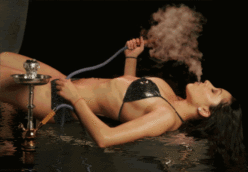Hubble-bubble (Nargile)
|
|
Hubble-bubble, or Nargile is one of the oldest traditions in Turkey and has enthusiasts of all ages and sexes who find great pleasure in smoking it. The original nargile came from India, but it was rather primitive as it was made out of coconut shells. The basic idea was to remove the inside of the coconut and dip a straw in its shell. Its popularity spread to Iran, where the word “nargil” means coconut in Persian, and to the Arab world. However the hubble-bubble completed its evolution in Anatolia when brought in the 17th century and having become a very important part of coffee house culture, has not changed its style for the last few hundred years. Even today the hubble-bubble continues to give a special breed of smokers enjoyment.Turkish craftsmen engraved beautiful designs such as clear, white or colorful bottles that look as if they were made out of crystallized ice, or more common designs like fruit or flowers.
Rules were created even for lighting the hubble-bubble and, as one of the main pastimes of the male population in the society, the preparation of the hubble-bubble was ceremonious and deliberately prolonged, especially for the eldest male in a family. In order to beautify old Turkish houses, a special corner was put aside where the hubble-bubble was placed.
A hubble-bubble consists four parts: Body, bowl, tube and mouthpiece.
Body-G??vde: This is the part where the bowl is placed and is filled with water in order to cleanse filth created by the burning tobacco and also to absorb the nicotine. Some professional hubble-bubble smokers used certain fruit like sour cherries or grapes in their g??vde just to enjoy the motion it created in the water. The body is usually made of glass; however more elegant ones are made out of porcelain, silver or crystal and embellished with gold, silver or coral. These bodies formed a unique type of Turkish handcraft and were mostly decorated with floral motifs.
Bowl-L?ºle: A specially-formed plug of tobacco (t??mbeki) is put in the bowl, which is pierced and covered with a conical cap so that that the flame may be sheltered on windy days. T??mbeki is a special tobacco; not all tobaccos qualified for usage in the hubble-bubble, as only special dark, strong, and very high-nicotine tobaccos found favor with hubble-bubble enthusiasts. This tobacco was washed several times before use, as it was extremely strong. Only oak charcoal was to be placed on the top of the tobacco.
Tube-Marpu?ß: A long flexible hose attached to the pipe and air in the body part, is conveyed by means of this tube. A marpu?ß might be embellished with embroidery, beadwork or other woven handicraft art. There may be more than one tube so that two or more people can smoke together while chatting. Atop the pipe is a small metal tray to catch cinders.
Mouthpiece-Aƒüƒ±zlƒ±k: At the end of the tube (marpu?ß) there is a mouthpiece to inhale the smoke. Don’t puff as strongly as on a cigarette. Rather, suck the smoke gently and don’t inhale deeply. The sucking should generate pleasant bubbling sounds in the water, which is part of the fun.
All pieces of the hubble-bubble were produced by special craftsmen, whose jobs were named after the pieces they produced. The areas where these craftsmen used to concentrate are called by these names ‚Äì even today there is an area called Marpu?ß?ßular in Covered Bazaar.
Now Turks don’t have as much time to sit and smoke hubble-bubble as their fathers and grandfathers did years ago. Unfortunately, like most wonderful things from the past, the hubble-bubble suffered a decline with the availability of the cigarettes, which forever changed the way Turks use tobacco. However, recently hubble-bubbles have caught the interest of the new generation in Turkey in search of their history and traditions, and at coffee houses and recently the swiftly-spreading nargile caf?©s you can see many people enjoying this old pleasure.
In addition to young Turks, tourists who visit Turkey are attracted to the hubble-bubble and often buy them as souvenirs to take home to their family and friends. The new fashion is hubble-bubble flavored with strawberries, apples or cappuccino. It takes about an hour to smoke a pipe full of fruit tobacco, two hours for the stronger stuff. The smoke is noticeably cooler than cigarette smoke, and lightly intoxicating.
Old Turkish hubble-bubble lovers state that smoking a hubble-bubble is nothing like smoking a cigarette and also add “Cigarettes are for nervous people, competitive people and people on the run. When you smoke a hubble-bubble, you have time to think. It teaches you patience and tolerance, and gives you an appreciation of good company. Hubble-bubble smokers have a much more balanced approach to life than cigarette smokers.” As long as there is a need for company and friendship, as long as people want to stop and think, there will be nargile caf?©s” is one of the most popular sayings nowadays.
(thank you to http://www.mymerhaba.com/ for much of this information)




